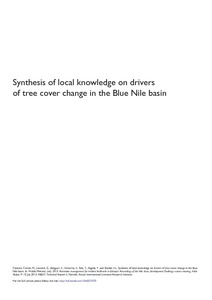Resource information
The quantity and position of trees in a landscape can have significant impacts on farm soil and water resources. Here we present a synthesis of local knowledge studies conducted in three micro-catchments of the Blue Nile Basin (Diga, Fogera and Jeldu Woredas) exploring natural and anthropogenic drivers of tree cover change. In total more than 90 purposively selected farmers were interviewed, whilst focus group discussions and feedback sessions were held with larger groups. Local knowledge revealed that all three sites suffered from rapid deforestation of native tree cover over the last 20 years. All three systems were recognized by farmers as declining in agricultural productivity. The decline of native forest in Jeldu was found to be more rapid than the other two sites, partially due to market pressures from the capital city. Fogera and Diga were found to have remnant native forest still present, although certain tree species had disappeared completely due to over-exploitation for their products. This was associated with population expansion which has driven land cultivation into more marginal land (such as steeper slopes and marshy lowlands), resulting in land degradation and heightened pressure on common grazing land. The farmers demonstrated detailed agro-ecological knowledge on how the physical attributes of trees impacted on water and soil resources. Farmers were able to describe the impacts of loss of native tree cover on erosion control, river bank stabilization, protection of headwaters and water quality improvements. There were knowledge gaps on how to integrate native trees into the cereal and horticultural cropping systems. The research findings suggest some potential policy changes and intervention strategies to reach farmers and increase understanding of the functions of trees in watershed management according to on-farm niches and ecosystem service provisioning.



